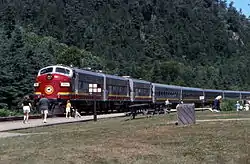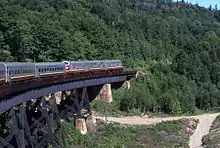Algoma Central Railway
The Algoma Central Railway (reporting mark AC) is a railway in Northern Ontario that operates between Sault Ste. Marie and Hearst. It used to have a branch line to Wawa, Ontario (formerly known as the township of Michipicoten). The area served by the railway is sparsely populated, with few roads.
 Algoma Central Railway's popular tour train stopped in the Agawa Canyon park | |
| Overview | |
|---|---|
| Headquarters | Sault Ste. Marie, Ontario |
| Reporting mark | AC |
| Locale | Northern Ontario |
| Dates of operation | 1899– |
| Technical | |
| Track gauge | 4 ft 8 1⁄2 in (1,435 mm) standard gauge |






The railway is well known for its Agawa Canyon tour train. Until 2015 the line also provided passenger train service to canoeists, snowmobilers, cottagers and tourists accessing this wilderness recreation region. The railway connects at its northernmost point with the Ontario Northland Railway and with CN's eastern division to the south. It also intersects with the Canadian Pacific Railway at Franz and with the Huron Central Railway at its southernmost point in the Sault.
History
The Algoma Central Railway was first owned by Francis H. Clergue, who required a railway to haul resources from the interior of the Algoma District to Clergue's industries in Sault Ste. Marie; specifically, to transport logs to his pulp mill and iron ore from the Helen Mine, near Wawa, to a proposed steel mill (which was later named Algoma Steel). The Algoma Central Railway was chartered on August 11, 1899.[1] The railway's Dominion and provincial charters gave it authority to build north from Sault Ste. Marie to a junction with the Canadian Pacific Railway's main line, as well as a branch line to Michipicoten Harbour, on Lake Superior near Wawa.
In 1901, Clergue acquired the charter of the Ontario, Hudson Bay and Western Railway, which was intending to build a line between the CPR main line and Hudson Bay. He then changed the name of the Algoma Central Railway to The Algoma Central and Hudson Bay Railway Company, anticipating a connection either to Moose Factory on James Bay or to some point on Hudson Bay.
The Algoma Central fell victim to the bankruptcy of Clergue's Consolidated Lake Superior Corporation in 1903.[1] At that time, the line reached 90 km (56 mi) north of Sault Ste. Marie, with a 32 km (20 mi) segment running east from Michipicoten Harbour that did not yet connect with the main line. Construction was stopped, but it was subsequently resumed in 1909 and the line was extended northward through to junctions with the Michipicoten Harbour branch (at Hawk Junction), the Canadian Pacific Railway (at Franz) and the Canadian Northern Railway (at Oba). In 1914, it finally reached Hearst, a town 476 km (296 mi) north of Sault Ste. Marie that was a divisional point on the National Transcontinental Railway.[1] By that point, Clergue's dream of building a railway to Hudson Bay or James Bay had long been abandoned, and the railway's northern terminus remained at Hearst, around 240 km (150 mi) from James Bay. However, the phrase and Hudson Bay was not removed from the railway's name until June 30, 1965.
The Algoma Central was the first Canadian railway to operate fully with diesel fuel, in 1952.[2]
In the 1960s, the railway began to promote the natural beauty of the District of Algoma to tourists, especially the Agawa Canyon, a canyon carved by the Agawa River, located 114 rail miles (183 km) north of Sault Ste. Marie, and not accessible by road.[3] The Algoma Central developed a tourist stopover here and it proved to be a great success for the railway. Owing to the popularity of the Agawa Canyon excursions, the Algoma Central would run the longest passenger trains in North America, often up to 20 to 24 cars long. During the 1970s and 1980s, around 100,000 people per year would tour Agawa Canyon.
The railway had been in the shipping business since 1900, when it had purchased four steamships. Starting during the 1960s, the railway greatly expanded its marine operations and diversified into trucking, real estate, forestry, and mining operations. These operations were more profitable than the railway operations, and on April 30, 1990, as part of a corporate reorganization, the name of the company was changed to Algoma Central Corporation, with the Algoma Central Railway becoming one of its subsidiary.[4] A few years later, the Algoma Central Railway was put up for sale.
Purchase by Wisconsin Central, Canadian National
On February 1, 1995, Wisconsin Central Ltd. purchased Algoma Central Railway Incorporated, operating the railway as a separate subsidiary, Wisconsin Central Canada Holdings. In 1998, Algoma Steel closed its iron ore mine in Wawa and the branch line between Michipicoten Harbour and Hawk Junction was abandoned.[2] Wisconsin Central Ltd. was acquired by Canadian National on October 9, 2001, whereupon the Algoma Central became part of CN's Eastern Division.
In January 2014, CN announced it was cutting the service from Sault Ste. Marie to Hearst blaming the Canadian federal government for cutting a subsidy necessary to keep the service running. The passenger service which runs three days per week provides year-round access to remote tourist camps and resorts. The average annual ridership is estimated to be 10,600 passengers. It has been argued in the past as an essential service; however, the service has always been deemed financially uneconomic.[5] The railway is the subject of the song Algoma Central 69 by Stompin' Tom Connors.
In February, a working group attempting to save the line hired BDO Canada LLP, an accounting firm, to assess the financial impact to the region when the service is scheduled to end April 29. The working group, composed of municipalities, first nations, and cottager associations all with a vested interest in the continuation of the service.[6] According to preliminary findings, BDO determined passenger rail service in the Algoma district generates between $38 million and $48 million in annual economic activity. It supports as many as 220 jobs and delivers more than $5 million in tax revenues.[7]
In April 2014, the federal government announced it would extend funding for one year so that CN rail would continue to provide the passenger service. The $2.2-million subsidy was to facilitate the provision of service until 2015.[8] In March 2015 it was announced that the passenger service would be assumed by Railmark Canada Ltd with the intention to increase services and marketing.[9]
In March 2015, the Canadian government guaranteed funding of the service for an additional three years.[10]
In June of the same year, Canadian National indicated they would stop the service July 15 after they were unable to find a deal with Railmark Canada. The government subsidy still stands but a new rail operator will need to be sought by the regional stakeholders group. Railmark was unable to secure a line of credit from a lending group which hindered its ability to take over services.[11]
The 2020 season of the Agawa Canyon tour train was cancelled due to the ongoing COVID-19 pandemic.[12]
Rail sidings
Rail sidings along the ACR route are named, from south to north: Odena, Heyden, Northland, Goulais, Wabos, Achigan, Ogidaki, Mashkode, Mekatina, Summit, Batchewana, Regent, Hubert, Frater, Canyon, Eton, Agawa, Tabor, Perry, Limer, Hawk Junction (Yard), Alden, Goudreau, Wanda, Franz, Scully, Hilda, Mosher, Dana, Langdon, Oba, Hale, Horsey, Mead, Coppell, Stavert (at the community of Jogues) and Wyborn (part of and on the west side of the town of Hearst).
References
- Wilson, Dale (1984). The Algoma Central Railway Story. Sudbury, Ontario: Nickel Belt Rails. ISBN 0-920356-05-2. See also: Duncan McDowall, Steel at the Sault: Francis H. Clergue, Sir James Dunn and the Algoma Steel Corporation, 1899-1956, Toronto: University of Toronto Press, hb 1984 & pb 1988 ISBN 0-8020-5652-0
- Boldt, Hans; S. Grisonich-Boldt. "Algoma Central Railway". Archived from the original on 6 December 2006. Retrieved 2006-12-15.
- "Algoma Central Railway FAQ". Canadian National Railway. Archived from the original on 6 December 2006. Retrieved 15 December 2006.
- "Algoma changes its name to inform investors it's more than a railway". Northern Ontario Business. Laurentian Publishing. 10 (9): 16. 1990-06-01.
- "CN to cut passenger service to Hearst". Northern Ontario Business. Retrieved 2014-01-28.
- "BDO to assess impacts of ACR passenger service". SooToday. Retrieved 2014-04-06.
- "Passenger rail provides "substantial economic benefit"". Northern Ontario Business. 2014-04-22. Retrieved 2014-04-23.
- Kelly, Lindsay. "Feds extend funding for Algoma passenger rail". Northern Ontario Business. Retrieved 2014-04-14.
- "Railmark finalizes agreement to run ACR passenger rail service". Northern Ontario Business. Northern Ontario Business. Retrieved 2015-03-13.
- "Harper government approves funding for ACR Passenger Rail Service under Railmark". Retrieved 2015-04-01.
- Ross, Ian. "CN pulls the plug on Algoma passenger trail". Northern Ontario Business. Northern Ontario Business. Retrieved 2015-06-12.
- "Agawa Canyon Tour Train". Archived from the original on 11 June 2020. Retrieved 11 June 2020.
It is with regret that we are announcing that the entire Agawa Canyon Tour Train 2020 season is cancelled in the interest of public health and safety. This decision is in line with existing restrictions at both the provincial and federal levels, as we continue to witness extended states of emergency and limitations on non-essential travel.
